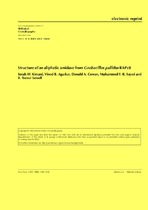| dc.contributor.author | Kimani, Serah W. | |
| dc.contributor.author | Agarkar, Vinod B. | |
| dc.contributor.author | Cowan, Donald A. | |
| dc.contributor.author | Sayed, Muhammed F. | |
| dc.contributor.author | Sewell, B. Trevor | |
| dc.date.accessioned | 2010-09-20T09:03:38Z | |
| dc.date.available | 2010-09-20T09:03:38Z | |
| dc.date.issued | 2007 | |
| dc.identifier.citation | Kimani, S.W., et al.(2007). The crystal structure of an aliphatic amidase from Geobacillus pallidus RAPc8: evidence for a fourth nitrilase catalytic residue. Acta Crystallographica. Section D: Biological Crystallography, 63:1048-1058. | |
| dc.identifier.uri | http://hdl.handle.net/10566/141 | |
| dc.description.abstract | The amidase from Geobacillus pallidus RAPc8, a moderate
thermophile, is a member of the nitrilase superfamily and
catalyzes the conversion of amides to the corresponding
carboxylic acids and ammonia. It shows both amide-hydrolysis
and acyl-transfer activities and also exhibits stereoselectivity
for some enantiomeric substrates, thus making it a potentially
important industrial catalyst. The crystal structure of
G. pallidus RAPc8 amidase at a resolution of 1.9 A ˚ was
solved by molecular replacement from a crystal belonging to
the primitive cubic space group P4232. G. pallidus RAPc8
amidase is homohexameric in solution and its monomers have
the typical nitrilase-superfamily α-β-β-α fold. Association in
the hexamer preserves the eight-layered α-β-β-α:α-β-β-α
structure across an interface which is conserved in the known
members of the superfamily. The extended carboxy-terminal
tail contributes to this conserved interface by interlocking the
monomers. Analysis of the small active site of the G. pallidus
RAPc8 amidase suggests that access of a water molecule to the
catalytic triad (Cys, Glu, Lys) side chains would be impeded by
the formation of the acyl intermediate. It is proposed that
another active-site residue, Glu142, the position of which is
conserved in the homologues, acts as a general base to catalyse
the hydrolysis of this intermediate. The small size of the
substrate-binding pocket also explains the specificity of this
enzyme for short aliphatic amides and its asymmetry explains
its enantioselectivity. | en_US |
| dc.language.iso | en | en_US |
| dc.publisher | International Union of Crystallography | en_US |
| dc.rights | Copyright International Union of Crystallography. Publisher permits author to archive publisher pdf. | |
| dc.source.uri | http://dx.doi.org/10.1107/S090744490703836X | |
| dc.subject | Geobacillus pallidus | en_US |
| dc.subject | Amidase | en_US |
| dc.subject | Industrial catalyst | en_US |
| dc.subject | Crystal structure | en_US |
| dc.subject | Hydrolase family | en_US |
| dc.title | Structure of an aliphatic amidase from Geobacillus pallidus RAPc8 | en_US |
| dc.type | Article | en_US |
| dc.privacy.showsubmitter | true | |
| dc.status.ispeerreviewed | true | |

